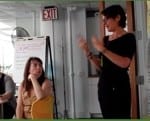 When to use
When to use
This process is best used at the beginning of a program or initiative or as an initial step in setting up an evaluation. It is a powerful tool to surface assumptions and support critical thinking and reflection while also strengthening planning processes and sharpening strategies. It also provides a framework for monitoring and evaluation, by focusing efforts on the outcomes that need to be tracked and documented. Theory of Action (ToA)/Theory of Change (ToC) can be used later on in the project life cycle, as participants can draw from assessments and reflections about ongoing work, and make mid-stream adjustments as needed.
How to use: Key ingredients
- A strong external facilitator
- Stakeholders at various levels of the organization or group, including leadership and people who normally don’t speak up, and/or participate in planning meetings, etc.
- Adequate time — 2 four hour blocks on different days would be a good start. The process can evolve over a period of months, as time allows.
- Tools AND space for placement of post-its, drawing, etc.
How to use: Basic steps
- Formulation of the long-term ‘vision’ of success that an organization or group wants to contribute to. How will the world/community, etc. be different in X years because of the work of X organization, program?
- Development of outcome “pathways”, or the shorter-term, smaller outcomes (or changes) that need to be achieved or exist in order for longer-term, broader outcomes to come about. These change pathways form an interlinked results chain, or web of cause-effect relationships, reflecting the ‘story’ of how the group believes the change will be achieved. Outcomes can be seen as changes in conditions, capacities, relationships, laws and policies, as well as behaviors.What earlier outcomes need to exist now in order to achieve near loner-term outcomes in support of our organization’s vision?
- Surfacing, testing assumptions. Surfaces the underlying beliefs and values of your program.Why do you believe the chain of shorter-term outcomes will achieve the longer-term vision? Do these outcome pathways make sense or are there any leaps in logic? Is anything missing?
- Discussion of context and external factors. Intended outcomes in complex social change work are achieved through the contributionS of many actors (Partners and allies). Which other actors could influence, either negatively or positively progress? Given this, how might we take into account this actors/factors in your ToA?
- Aligning strategies/activities. Even programs in the planning stages have some understanding of strategies, capacities, relationships that are needed or that exist. These need to be introduced into the process, such as by putting THEM at the bottom of the emerging change map. Where are these elements in line with the what has emerged in the change map? Is there anywhere that more effective strategies might be suggested? Overall, will these strategies achieve these outcomes?
- Testing the logic. With stakeholders or allies that weren’t part of the initial process discuss the vision, assumptions, logical linkages between outcomes and choices of strategies. Make revisions based on discussions.
- Use it! The Theory of Action or Theory of Change is a framework for monitoring and evaluating your work (an outcomes framework) as well as an important tool to support planning, organizational learning, and strategic planning and adaptation. Periodically, as new information is received about the effectiveness and challenges of program implementation, go back and discuss assumptions, see how strategies are aligned, and consider what changes might need to be made. Change maps can also be used effectively as communication tools.
(Note: the method can be adapted to particular needs of groups involved. There isn’t one ‘right’ way.)

[…] work with and have integrated other tools, particularly to build on ToA for action planning. (See Basic Steps and Tips and Lessons Learned). While we found discussions on the logical linkages between […]